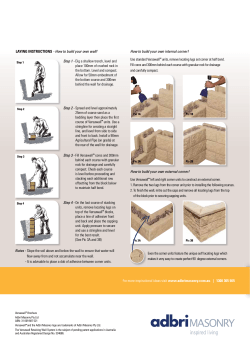
Construction of the "4 lines decoder”
Construction of the "4 lines decoder”
for reading information contained in 406 beacon message
Jean-Paul YONNET
F1LVT / ADRASEC 38
F1LVT@yahoo.fr
www.F1LVT.com
We will describe the construction of the "four lines" decoder step by step. This
decoder is able to read messages of 406 beacons and it can display on 4 lines the
information contained in the message [1,2]. The time of reception is recorded and
displayed, and it is possible to recall the previous messages. Associated with a
receiver tuned on the beacon frequency, the decoder operates completely
independent. To get a good reception, it is better to use the output "discriminator" on
the receiver.
For the decoder construction, all the key components must be collected: the
programmed PIC 18F2685 (now it is the version vB2E or vB2F), the display 4 lines of
20 characters, the printed circuit board / PCB [3] and all the peripheral components.
The version V24 of the PIC program can be downloaded on the website
www.F1LVT.com. The latest version (vB2E or vB2F) are only available on
programmed PIC (contact F1LVT).
For the 20 x 4 characters display module, we prefer using black lettering on green
background with green backlight (or possibly yellow). These displays are very
readable, even without backlighting.
Reversed display also exists, where the characters are white on a blue
background, which must be backlit. No display backlight, and display requiring a
negative voltage to operate must be avoided.
Note: the PCB described in the article presenting the decoder ("Display on 4 lines
of information contained in the message of a 406 beacon") [1, 2, 3] is a general
support for multiple variants.
-- For example, most capacitors have three holes implantation allowing the use of 5.1
mm or 7.6 mm step.
-- The power supply of input signals circuit can be installed either independently with
a 78L05 or a 78L08, or shared with the 5V PIC power supply (7805). In the latter
case, it is necessary to add a bridge between the power supplies.
-- It is possible to build an autonomous system with a small 9V battery. The tracks
allow mounting with a series resistor and a LED to show that the battery is charging.
We will describe in this paper only the construction of the basic system,
power supplied by 12V (at least 8V), with all circuits powered by a single 5V
regulator, a 7805 IC.
Construction of the « 4 lines » 406 decoder
www.F1LVT.com
1
The steps of construction
During the construction, a series of tests has been defined. If the decoder does
not correctly respond to these tests, don’t go further. Look first at the fault origin.
We will describe the construction steps.
1–
Drill the PCB with a 0.8 mm drill. Five holes (4 for fixing the display and 1 for
the7805 IC) must be enlarged to 3 mm. Before soldering, be sure that the PCB is
correctly etched and degreased.
2–
Fit the 4 wire bridges. Two are situated under the PIC, one is under the 74HC14
IC (ground connection), and an optional one close to Push Buttons (ground
connection) (Photo 1).
Be careful there are also three bridges on the PCB, on the copper side. These
connections are explained later in the description of the construction (see step 4 for
5V, step 9 to PIC pin 1 / optional, and step 12 for the lighting of the display).
Photo 1: The PCB and the bridges to be realized
3–
Solder the three IC sockets (8 pins for the amp, 28 pins for the PIC and to 14 pins
for the Schmitt Trigger gates). For each socket, the pin 1 can be recognized on the
PCB by its rectangular shape.
Construction of the « 4 lines » 406 decoder
www.F1LVT.com
2
4–
Solder the components of the power supply: the 7805 regulator with its filter
capacitors (C41, C42, C43) (Figure 1). Solder the capacitors of the power supplies IC
(C11, C23, C24) and the potentiometer 10 kΩ (P11).
Figure 1: The power supply
To mount the 7805 regulator, enlarge the connection holes to 1 mm. The ground
is connected by the radiator, so it is imperative to put a screw securing the 7805
heatsink on the PCB (Photo 2). Elsewhere, make a connection between the middle
pin of the 7805 IC and the ground.
The PCB allows the installation of a separate regulator for the amplifier TLC272,
to be able to power it with a higher voltage, for example with 8V regulator. The
location of the regulator is next to the capacitor C23. With all circuits powered by a
single 5V regulator (the case of the basic construction that we are doing), add a
connection between the supply tracks. This link appears in green on the Figure
showing the component position, between the TLC272 and R11.
Photo 2: The power supply components and the IC sockets on the PCB.
For the construction with only one regulator, do not forget to bridge the 5V copper
tracks.
Construction of the « 4 lines » 406 decoder
www.F1LVT.com
3
5–
Solder the 2 wires of the power supply.
Test # 1
To verify that the power supply is correctly working, it is necessary to power the
system by 12 V (8 to 15 V) and check that the voltage is 5V on pin 20 of PIC socket,
on pin 14 of 74HC14 socket, and particularly check the 5V on pin 8 of the TLC272. It
is a common failure of forgotten bridge between the 5V power supplies (see Step 4).
6–
Place the 2 sockets 6-pin male on the PCB, on the copper side (see Photo 3).
When the pins were introduced, push pins with pliers to get them out to the maximum
on the copper track side. On the component side, only the thickness of the support is
remaining. The pins must be soldered on the copper side.
Photo 3: The two 6-pin connectors which are soldered on the copper side
7–
Solder the two 6-pin female connector for the display connection (pins 1-6 and 1116 of the display) (Photo 4). As display holes are metallized, it is possible to solder on
the display side.
8–
Use spacers of 10 mm long to obtain a parallel position between the PCB and the
display plane. The display can be disassembled and reassembled easily.
Construction of the « 4 lines » 406 decoder
www.F1LVT.com
4
Photo 4: The two 6-pin female connectors soldered under the display
Test # 2 / Adjustment # 1
Power ON with the installed display and adjust the potentiometer 10 kilohms to
make appearing a series of black squares █ on the first and third line of the display
(Photo 5).
Photo 5: Setting the display contrast
Construction of the « 4 lines » 406 decoder
www.F1LVT.com
5
9–
Power Off, the PIC is now inserted in its socket (Photo 6).
It is not necessary to solder R11. The PIC uses its internal reset. R11 and diode
1N4148 series are only used when programming the PIC directly on the PCB. With
an already programmed PIC, R11 and the diode (not shown in Scheme 2) are not
necessary. You can make a bypass at the location of said diode (labeled in green
color on the layout diagram).
Figure 2: The PIC and the display
Photo 6: The PIC is placed on its socket
Construction of the « 4 lines » 406 decoder
www.F1LVT.com
6
Test # 3
Power ON with the display and the PIC; the home page should appear on the 4
lines display (Photo 7).
Photo 7: With programmed PIC putted on its socket,
the home screen appears when power ON
10 –
Mount all components of the input circuit (Figure 3). Adjust the level potentiometer
at halfway (Photo 8).
Figure 3: The signal input and circuit. It has been previously used by F6HCC.
Construction of the « 4 lines » 406 decoder
www.F1LVT.com
7
Photo 8: Addition of the input circuit components.
Preposition the potentiometer P21 at halfway
Test # 4 / Adjustment # 2
Preposition the potentiometer P21 at halfway. Apply power and send a signal to
the input. This signal can be given either by a frame generator, or by a recorded
frame. The message should be displayed.
The input level (P21 potentiometer) can be slightly adjusted for adaptation to the
source and to find the best position. This level depends on the receiver.
Photo 9: Information included in the beacon message is displayed.
Construction of the « 4 lines » 406 decoder
www.F1LVT.com
8
Photo 10 shows all the components which must be soldered on the PCB of the
decoder circuit.
Photo 10: The decoding of another message beacon.
The display is connected to the map by a series of wires
11 –
Mount the LED and its load resistor R13. The LED should be soldered on the
copper side of the PCB to be seen from the display side.
In operation, the LED should light up during the signal processing by the PIC.
LED lights up by supply of 5V voltage on pin 7 of the PIC. In order to put the LED
in the good position, you can remove the PIC and put a wire between pins 7 and 20
on the socket of the PIC, and power ON: the LED should light continuously.
Construction of the « 4 lines » 406 decoder
www.F1LVT.com
9
12 –
The display illumination (D41 and R12) is not mandatory, but it helps readability.
For the resistor R12, 220 Ω is noted in the list of components, 440 Ω on Figure 2 and
470 Ω on the component position (Figure 6 and 7). In fact the resistance R12
supplies the LED lighting of the display. The value depends on the used display
module. According to the manufacturers and to the type of display and its backlight,
the value of R12 must be adjusted by testing. Attention to the power dissipated by
the resistance. Put two resistors in parallel if the heating is too important.
Besides R12, it is possible to mount a 3-pin socket with a strap, which can be
used to power or not lighting. When this function is not used, add a connection
between the tracks, which appears in blue on the color layout diagram (Figure 7).
Photo 11: PCB with the display lighting circuit,
the LED displaying the decoding is soldered on the other side
Operation test
At this step of construction, the decoder is fully operational for decoding received
beacon message. By sending a 406 message (recorded message or message
provided by a frame generator), the LED should light up and the display will show the
information on 4 lines.
Construction of the « 4 lines » 406 decoder
www.F1LVT.com
10
13 To finish the construction, the components of the accessories parts must be
added:
- Installation of GPS reception parts,
- Mounting the two pushbuttons to access to the memories.
Figure 4: Reading time by receiving GPS data
Notes
-- If the receiver is powered by a 9V battery, limit the value of capacitor C43 to 47 µF
or 100 µF for a fast enough voltage rise at startup.
-- Between IC22 and R24, a resistor location is unoccupied when only one 5V
regulator is used. A resistor must be putted if a higher voltage than 5V is used for the
input circuit (TLC272), for example 8V, to match the levels between the amplifier
output and 74HC14.
-- Same remark for the unoccupied location next to C23. It is the place of the second
regulator if a separate power supply is used for the amplifier.
-- The edge of the PCB (which is marked 12V) is not used. If the decoder is supplied
by a 9V battery, this section allows you to place a series resistor and a LED. At the
top and bottom of this section, a socket-3.5mm input for the beacon signal and a
base of 2.5 Jack for the arrival of the GPS signal can be placed.
-- The decoder has been designed with a PIC, which complete reference is
"18F2685 I-SP". It can also work with a “18LF” instead of “18F”, or a “E-SP” version
in place of the “I / SP” [5].
-- The software inside the PIC has slightly evolved. The version “V24” (2012) is now
updated to version “vB2E” (in English) or “vB2F” (in French). In particular, the
memories management has been improved. The first version “V24” is freely available
on the website www.F1LVT.com. The following versions are available only with
preprogrammed PIC and cannot be copied from a PIC to another one.
Construction of the « 4 lines » 406 decoder
www.F1LVT.com
11
Notes on operation
-- For a correct working, do not you take the signal to the LF Jack (headphone Jack).
The output "discriminator" of the receiver must be used, that is to say the direct
output signal of the demodulator
The website "discriminator.nl" [6] is very well documented to explain how to
install an outlet "discriminator" in a receiver.
-- At the signal input of the decoder, the level (setting of P21) depends on the
receiver. Ideally it would adjust the level using an adjustable beacon signal level, and
make the adjustment on the limit of decoding. In practice, the adjustment at halfway
of P21 corresponds to a value well suited to many receivers.
-- The decoder works with both positive signals (start of frame by ∆ϕ +) and negative
signals (start of frame by -∆ϕ).
-- The use of GPS is optional; decoding works fine without GPS. The GPS allows
recording the time of arrival of the 406 signal. If the GPS is not connected, the display
of the time indicates “8888”. The letter “Z” after the time is added by the decoder (as
a reminder that this is GMT).
-- With the version “V24”, the reading of memories is a secondary function. This
reading must be done when no new data is recorded. Ideally with “V24”, unplug the
entrance.
With more recent versions, the reception of a new signal has priority on
memories reading, allowing a full compatibility between the memories reading and
the new 406 signal reception.
Références
[1] http://www.f1lvt.com/files/321Eng-Decodeur406-Part1.149.pdf
http://www.f1lvt.com/files/321-Decodeur406-Part1.81.pdf
[2] http://www.f1lvt.com/files/321Eng-Decodeur406-Part1.149.pdf
http://www.f1lvt.com/files/322-Decodeur406-Part2-V2.123.pdf
[3] http://www.f1lvt.com/files/323-CI-RxTrames406-V2.156.pdf
[4] http://www.f1lvt.com/files/324-RX406-V24.83.hex
[5] http://www.f1lvt.com/files/326-VariantesPIC.132.pdf
[6] http://discriminator.nl/index-en.html
Construction of the « 4 lines » 406 decoder
www.F1LVT.com
12
Figure 5: PCB (seen through epoxy)
Figure 6: Component position
Figure 7 (next page): Component position in color
Construction of the « 4 lines » 406 decoder
www.F1LVT.com
13
Construction of the « 4 lines » 406 decoder
www.F1LVT.com
14
Component list
Active Components:
IC11 Microcontroller
IC21 Amplifier
IC22
IC31 Opto-coupler
IC41 Regulator
LED
D31
D41
Display
IC11 PIC 18F2685-I/SP DIL28
IC21 TLC272
DIL8
IC22 74HC14
DIL14
CNY 17-3
DIL6
7805
Red Φ3 mm (eventually 5 mm)
1N4148 (or equivalent)
1N4004 (1N4001 to 1N4007)
LCD 20 x 4 (dimensions 98 x 60 mm)
Resistors
R11
R12
R13, R14, R15
R21
R22, R23
R24
R25
R26
R27
R31
R32
R33
R41
10 kΩ (facultative / See text)
220 Ω (to be adapted at the lighting level)
470 Ω
12 kΩ
150 kΩ
1,5 MΩ
4,7 kΩ
5,6 kΩ
10 kΩ
330 kΩ
10 kΩ
470 Ω
100 Ω
P11, P21
10 kΩ linear potentiometer for PCB
Condensators
C11, C13, C14
C21
C22
C23, C24
C41, C42
C43
470 nF
100 nF
220 pF
470 nF
470 nF
1000µF/10V electrochemical
(between 100 et 1000µF)
For the filtering condensators (C11, C13, C14, C23, C24, C41, C42) of 470nF,
other values like 220nF, or 100 nF can be used.
Complement
K
Switch ON – OFF
BP1, BP2
2 Push Buttons
CI sockets
28 pins, 14 pins, 8 pins, 6 pins
Chassis Jack 3,5 (connexion récepteur)
Chassis Jack 2,5 (connexion GPS)
Display connector for the display (2 connectors with 6 pins)
Construction of the « 4 lines » 406 decoder
www.F1LVT.com
15
Several examples of the « 4 lines Decoder » construction
Photo E1: “4 lines decoder” in construction by F1AVR.
Test with an Exercice Beacon
Photo E2: Another version seen from bottom. The ground plane near the PIC has
been used to place a chassis Jack 3.5 for the input signal
Construction of the « 4 lines » 406 decoder
www.F1LVT.com
16
Photos E3: Prototype supplied by a 9V battery.
The autonomy is about 10 hours of operation.
Construction of the « 4 lines » 406 decoder
www.F1LVT.com
17
© Copyright 2025












